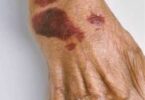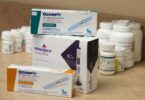F.P. Report
ISLAMABAD: Type 2 diabetes is the most common form of diabetes. It occurs when blood sugar levels rise due to issues with how the body uses or produces insulin.
It can appear at any age, but it is more likely to occur after the age of 45 yearsTrusted Source. In 2019, 37.3 million Americans had diabetes, mostly type 2.
This article examines the early signs and symptoms of type 2 diabetes, the risk factors, and potential complications.
What is type 2 diabetes?
Type 2 diabetes occurs when a person’s body no longer responds to insulin correctly. This is called insulin resistance. After some time, the pancreas makes less and less insulin.
Insulin is a hormone that regulates the movement of blood glucose, or sugar, into cells, which use it as energy.
When sugar cannot enter cells, too much glucose collects in the blood, and the body cannot use it for energy.
A doctor may diagnose diabetes if a person’s blood sugar levels are 126 milligrams per deciliter (mg/dl) or above after fasting for 8 hours.
What are the risk factors for diabetes?
Symptoms
The symptoms of high blood sugar in type 2 diabetes tend to appear gradually. Not everyone will notice symptoms in the early stages, but they may appear over time.
If symptoms do occur, they may include the following:
Frequent urination and increased thirst
When too much glucose builds up in the bloodstream, the kidneys cannot reabsorb it. The body removes the excess glucose in the urine, taking water from the body with it. This can lead to excessive thirst and the need to drink and urinate more.
Weight loss
When there is too little insulin, the body may start burning fat and muscle for energy. This causes weight loss.
Fatigue
When cells lack glucose, the body becomes tired. Fatigue can interfere with daily life when a person has type 2 diabetes.
Blurred vision
High blood glucose can cause fluid to be pulled from the lenses of the eyes, resulting in swelling, and leading to temporarily blurred vision.
Infections and sores
A person may notice itching around the penis or vagina or frequent Candida infections. Infections and sores may take longer to resolve because diabetes impacts blood circulation.
If people notice these symptoms, they should consult a doctor. Diabetes can lead to several serious complications. The sooner a person starts managing glucose levels, the better the chance of preventing complications.
Symptoms in children and teens
Type 2 diabetes is more likely to appear after the age of 45 yearsTrusted Source, but it can affect children and teens who:
• have a high body mass index (BMI) for their age
• do not do much physical activity
• have high blood pressure
• have a family history of type 2 diabetes
• areTrusted Source Black American, Asian American, Hispanic American, or Native American
Symptoms will be the same as for adults, as mentioned above.
If a child or teen has these symptoms, they should talk with a doctor. They may be signs of type 2 diabetes but can also indicate type 1 diabetes.
Type 1 is less common but more likely to affect children and teenagers than adults.
Symptoms in older adults
Around 29.2% of people aged 65 and above have type 2 diabetes in the United States. They may have some or all the classic symptoms of type 2 diabetes.
They may also experience one or more of the following:
• flu-like fatigue, which includes feeling lethargic and chronically weak
• urinary tract infections
• numbness and tingling in the hands, arms, legs, and feet due to circulation and nerve damage
• dental problems, including infections of the mouth and red, inflamed gums
Early skin symptoms
Diabetes can lead to a range of skin changes, some of which may be early warning signs.
Examples include:
• acanthosis nigricans, areas of darker, velvety skin, especially on the neck, elbows, knees, and knuckles
• necrobiosis lipoidica, raised patches that may be yellow, red, brown, or darker than the surrounding skin and that may become swollen and hard
• digital sclerosis, when hard, thickening, or swollen skin appears on the hands, possibly spreading to the arms and elsewhere
• painless blisters that suddenly appear
• wounds that take longer to heal
• frequent skin infections
Learn more about the early signs of type 2 diabetes.
Prediabetes
A person with prediabetes will not have any symptoms, but they will have blood sugar levels of 100–125 mg/dl.
Their blood sugar levels are high, but they do not have diabetes. Taking action at this stage can prevent diabetes from developing.
The Centers for Disease Control Prevention (CDC) estimate that around 96 millionTrusted Source American adults have prediabetes, but 80% do not know they have it.
Complications
Diabetes may cause a number of health complications if people are unable to manage it. Many are long term, but some need immediate medical attention.
Emergency complications
Complications can arise quickly if blood sugar rises or falls too far.
Hypoglycemia
Hypoglycemia, or low blood sugar, is when blood glucose dips below 70 mg/dlTrusted Source.
This can happen if a person who uses insulin takes more than they need for a particular time. It can also occur with other medications that treat diabetes, such as sulfonylureas.
A home blood glucose test can check for hypoglycemia.
It is vital to know the early signs of hypoglycemia, as it can progress quickly, resulting in seizures and a coma. In the early stages, however, it is easy to treat.
Symptoms of hypoglycemia include:
• confusion
• dizziness
• feeling faint
• heart palpitations
• rapid heartbeat
• mood changes
• loss of consciousness
• sweating
• clamminess
If symptoms are mild, a person can often resolve low blood sugar levels by consuming 15 grams (g) of carbohydrates, for example, by consuming:
• 4 ouncesTrusted Source of orange juice
• 4 glucose tablets
• a tablespoon of honey or sugar
The person should then wait 15 minutesTrusted Source, test their blood sugar, and if it is still low, repeat the process with another 15 g of carbohydrates.
When levels return to above 70 mg/dl, the person should eat a meal, to stabilize their glucose levels.
If glucose levels remain low or symptoms worsen, someone should take the person to the emergency room.
Anyone who has frequent or severe hypoglycemic episodes should speak with a doctor, as they may need to adjust their treatment plan.
Hyperglycemia and diabetic ketoacidosis (DKA)
If blood sugar levels rise too far, hyperglycemia can result. If a person notices increased thirst and urination they should check their blood sugar levels.
If the level is above the target level agreed with a doctor, the person should do some exercise to reduce the level.
However, a person should not exercise if their blood glucose levels are 240 ml/dl or above, as this could be a sign of diabetic ketoacidosis (DKA).
DKA can develop if a person has hyperglycemia and does not take action to reduce it. DKA happens when high levels of ketones collect in the blood, making it too acidic. For this reason, the person should also test their ketone levels.
Ketoacidosis can lead to:
• difficulty breathing
• a fruity smell on the breath
• a dry mouth
• nausea and vomiting
• coma
A person with these signs and symptoms should seek immediate medical attention, as DKA can be life threatening.
People who regularly experience high blood sugar should discuss adjusting their treatment plan with their doctor.
What types of diabetic emergencies are there?
Long-term complications
Keeping blood glucose within target levels can prevent long-term complications.
Here are some complications that can ariseTrusted Source:
• cardiovascular disease
• high blood pressure
• nerve damage (neuropathy)
• eye damage and vision loss
• kidney disease
• foot problems
Effective management of blood glucose levels can reduce the risk of complications. (Online)






